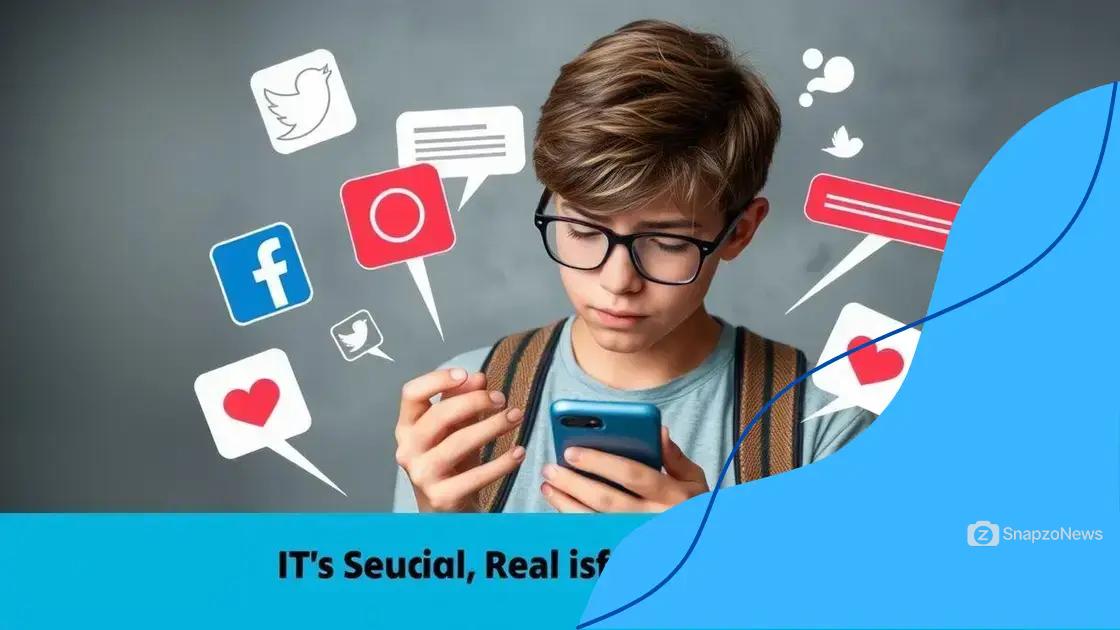The impact of social media on student mental health

The impact of social media on student mental health includes both positive effects like community building and negative issues such as cyberbullying and low self-esteem, highlighting the need for awareness and healthy usage strategies.
The impact of social media on student mental health is a topic that resonates with many today. It’s fascinating—and at times concerning—to see how platforms influence feelings and behaviors among students. Ever thought about how scrolling through your feed might change your mood?
Understanding the link between social media and mental health
Understanding the link between social media and mental health is crucial, especially for students. Today, many young people are active on various platforms, which can influence their mental state significantly. This connection is complex, with both positive and negative effects observed among users.
Positive Connections
On the bright side, social media can serve as a support system. Many students find connection and community online, which can boost their self-esteem and provide comfort during tough times. Engaging with friends through social media may also help reduce feelings of loneliness.
- It allows friendships to thrive, even from a distance.
- Students can share experiences and resources for mental well-being.
- Support groups for various issues are easily accessible.
However, these benefits must be balanced with awareness of the potential downsides. The pressure to maintain a perfect online image can lead to detrimental effects on a student’s mental health.
Negative Effects
Students may experience anxiety or depression because of things they see online. Cyberbullying is a real concern, causing distress and affecting self-worth. The comparison trap is another significant factor where students often compare their lives to the seemingly perfect lives of others.
- Cyberbullying can lead to serious mental health problems.
- Constant comparisons can create feelings of inadequacy.
- Overusing social media may lead to addiction, decreasing real-life interactions.
It’s essential for students to reflect on their social media habits. Recognizing when these platforms affect their mood can help in making healthier choices. Creating a balance between online interactions and real-life connections encourages better mental health. By understanding how social media impacts their lives, students can navigate these platforms more wisely.
Positive effects of social media on students
Positive effects of social media on students are often overlooked in a world that frequently focuses on the negatives. However, when used wisely, social media can offer students a range of benefits that enhance their educational experience and social interactions.
Building Community
One of the significant advantages is the ability to build a sense of community. Students can connect with peers who share similar interests, creating friendships that may not have occurred in traditional settings. Through various platforms, they can engage in discussions and share ideas easily.
- Support groups for academic subjects allow for collaborative learning.
- Access to communities focused on hobbies can enhance social skills.
- Global connections provide diverse perspectives and ideas.
This sense of belonging can have positive implications for student mental health, fostering confidence and a feeling of inclusion.
Access to Resources
Social media serves as a powerful tool for information sharing. Students often exchange valuable educational resources, tips, and advice online. This enhances their learning opportunities beyond the classroom.
- Links to educational articles and videos make learning accessible.
- Discussion forums can clarify doubts and reinforce knowledge.
- Online study groups create accountability and motivation.
Moreover, students can express their thoughts and creativity through various mediums on social media. This expression can lead to the development of new skills, ranging from writing to graphic design. Engaging creatively can also serve as an outlet for stress and anxiety.
Staying Informed
Staying updated on current events is another important benefit. With social media, students can access news and information quickly, which encourages them to be aware of the world around them. This awareness can stimulate discussions and critical thinking.
In summary, the positive effects of social media on students are undeniable. From building community and accessing resources to enhancing creativity and staying informed, there are multiple ways that these platforms can contribute to students’ personal and academic growth.
Negative impacts of social media usage

The negative impacts of social media usage on students are an important issue to discuss. While social media can connect people, it can also lead to various mental health problems. Many students face challenges related to anxiety, depression, and low self-esteem because of their online interactions.
Cyberbullying
One significant concern is cyberbullying. This type of bullying occurs online, and it can have devastating effects on students. Unlike traditional bullying, cyberbullying can happen anytime and anywhere, making it hard to escape.
- It can lead to feelings of isolation and sadness.
- Victims often experience fear and anxiety.
- Affected students may struggle academically due to emotional distress.
Additionally, being a victim of cyberbullying can result in serious long-term effects, including trauma and a lack of trust in others.
Comparison and Self-Esteem
Another issue is the constant comparison that students face online. Social media often portrays an idealized version of reality, leading students to feel inadequate. They might compare their lives to the edited images and stories of others, which can severely impact their self-esteem.
- Students may develop body image issues from unrealistic standards.
- They might feel pressure to present a perfect life online.
- This comparison can lead to anxiety and depression.
This struggle becomes a cycle where the more time students spend on social media, the worse they feel about themselves. Understanding these effects can help students be more mindful of their social media habits.
Addiction and Distraction
Excessive use of social media can also lead to addiction. Students may spend hours scrolling through feeds, which can distract them from studies and personal interactions. This addiction can decrease their academic performance and affect relationships with friends and family.
It’s essential for students to recognize these negative aspects of social media. By taking breaks and setting limits on usage, they can protect their mental health and focus on what truly matters.
Strategies for healthy social media use
Using social media can be a great way to connect with others, but it is essential to develop strategies for healthy social media use. These strategies help students enjoy the benefits while minimizing the negative impacts.
Set Time Limits
One effective strategy is to set time limits on social media usage. This can prevent excessive scrolling and promote a healthier balance between online and offline activities. Using apps to track screen time can provide insight into usage habits.
- Try setting a daily limit for social media usage.
- Use timers to remind yourself when to take breaks.
- Engage in offline activities to fill the time spent online.
Taking breaks can refresh your mind and help improve focus in other areas, such as schoolwork or hobbies.
Be Mindful of Content
Being mindful of the content consumed on social media is also crucial. Following positive accounts that inspire and educate can enhance mental well-being. Similarly, it’s important to unfollow or mute accounts that evoke negative feelings.
- Choose accounts that promote positivity and self-improvement.
- Limit exposure to news or topics that cause anxiety.
- Engage with content that enriches knowledge and creativity.
This selective approach creates a healthier online environment that feels uplifting rather than draining.
Establish Boundaries
Establishing boundaries around social media use helps maintain a healthy relationship with it. For example, avoiding social media during meals or before bedtime can enhance focus on real-life interactions and improve sleep quality.
By creating designated times for social media interaction, students can avoid distractions during important study sessions or family time. This also encourages deeper connections with friends and family.Regular breaks from social media can improve mental clarity and reduce stress.
Practice Digital Detox
Finally, consider scheduling a digital detox. Setting aside specific days or weekends away from social media can help reset habits and improve overall mental health. During these breaks, students can explore other interests or spend time with loved ones, creating a more balanced life.
By implementing these strategies for healthy social media use, students can enhance their online experience, prevent negative impacts, and promote better mental health.
Resources for students facing mental health challenges
Students facing mental health challenges can find support through a variety of resources. These resources are essential for guiding students toward healing and understanding their mental well-being. By utilizing these tools, students can better manage their feelings and experiences.
Professional Help
One of the most effective resources is seeking professional help. School counselors and psychologists are trained to support students dealing with mental health issues. They can provide a safe space to explore feelings and develop coping strategies.
- Counselors can offer individual therapy sessions tailored to student needs.
- Group therapy provides a supportive environment where students can share experiences.
- Professional help can guide students through crises effectively.
Having someone to talk to can make a huge difference in a student’s life.
Hotlines and Support Groups
Another valuable resource is mental health hotlines and online support groups. These services allow students to gain immediate assistance during tough times. Hotlines offer anonymous support, providing a sense of relief and understanding.
- National hotlines can connect students with trained professionals 24/7.
- Online support groups foster connections with peers facing similar challenges.
- Anonymity can empower students to share their feelings freely.
Support from others can help combat feelings of isolation.
Apps and Online Resources
There are also various apps and online resources designed to help students manage their mental health. These can offer tools for mindfulness, stress relief, and mood tracking. Such technology can encourage students to take charge of their emotional wellness.
- Mindfulness apps guide users through relaxation techniques.
- Journaling apps help students express their thoughts and feelings.
- Mental health websites provide information and coping strategies.
Using these apps can create positive habits that support mental health over time.
Peer Support
In addition to professional resources, peer support plays a vital role. Establishing a network of friends who understand can provide comfort and reduce feelings of loneliness. Students can practice reaching out to friends or creating study groups where mental health is openly discussed.
Building connections with others facing similar struggles can reinforce resilience and provide encouragement during challenging times. Utilizing these resources for students facing mental health challenges is key to developing healthier coping strategies and feeling more connected.
FAQ – Frequently Asked Questions about the Impact of Social Media on Student Mental Health
What are the positive effects of social media on students?
Social media can help students connect with peers, build supportive communities, and access helpful resources for their mental health.
How can cyberbullying impact students?
Cyberbullying can lead to feelings of isolation, anxiety, and low self-esteem, significantly affecting a student’s mental health.
What strategies can students use for healthy social media use?
Students can set time limits, be mindful of the content they follow, establish boundaries, and practice digital detox to maintain a balanced online experience.
Where can students find resources for mental health support?
Students can access school counselors, hotlines, online support groups, mental health apps, and peer support networks to address mental health challenges.
